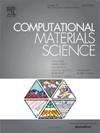Unraveling the role of temperature on the onset of ejecta formation at atomic scales
IF 3.1
3区 材料科学
Q2 MATERIALS SCIENCE, MULTIDISCIPLINARY
引用次数: 0
Abstract
Shock wave interactions with perturbations on a free surface can lead to the inversion and growth of the perturbation and eventual ejection of a jet of material, referred to as an ejecta microjet, from shocked surfaces. This study carries out large-scale molecular dynamics (MD) simulations using single-crystal Cu and Sn systems with a pre-existing groove to characterize the localized gradients in temperatures and pressures generated that render the microjet formation. MD simulations are carried out for three loading orientations (along the [001], [011], and [111] directions) and shock pressures ranging from 16 GPa to 100 GPa to understand the role of temperatures generated at the groove vertex on the formation of ejecta. The simulations suggest that the interaction of the shock wave with the groove results in a localized increase in temperatures, leading to localized softening at the groove vertex and the generation of an ejecta microjet. For Cu systems, the simulations suggest that the orientation effects on shock wave structures, velocities, and localized softening affect the ejecta formation at low pressures. Jetting is only observed when temperatures at the groove vertex are high enough to induce localized softening (close to melting temperature), and the jet velocity increases with shock pressure. In contrast, the loading orientation is rendered inconsequential for Sn systems due to the melting of the material during shock compression at the pressures chosen. The jet velocities are similar, regardless of crystal orientation in Sn systems.

求助全文
约1分钟内获得全文
求助全文
来源期刊

Computational Materials Science
工程技术-材料科学:综合
CiteScore
6.50
自引率
6.10%
发文量
665
审稿时长
26 days
期刊介绍:
The goal of Computational Materials Science is to report on results that provide new or unique insights into, or significantly expand our understanding of, the properties of materials or phenomena associated with their design, synthesis, processing, characterization, and utilization. To be relevant to the journal, the results should be applied or applicable to specific material systems that are discussed within the submission.
 求助内容:
求助内容: 应助结果提醒方式:
应助结果提醒方式:


